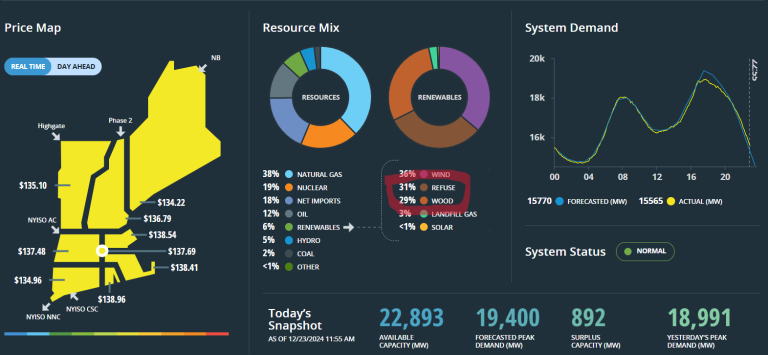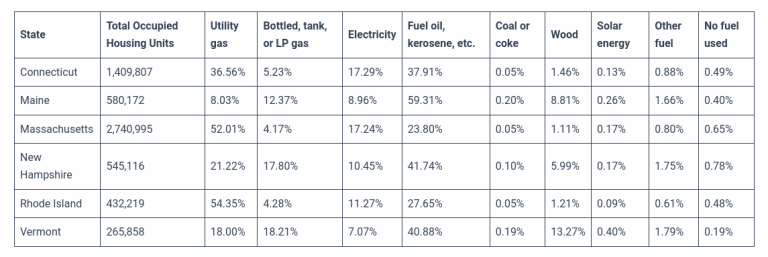Eagle-eyed New England energy observer Meredith Angwin of Wilder pointed out an inconvenient fact on X this Monday: when it’s cold (like this week) and people are home more than usual (like this week), ‘green’ New England burns oil and coal to make electricity.

“We are having our first real cold snap,” the author of Shorting the Grid said five days ago. “It will get below zero F tonight. And at 4:15 p.m. our grid was already dependent on oil.”
Indeed. According to another Dec. 23 (11;55 AM) ISO-New England energy resource snapshot posted early this week by Angwin, about one one in eight (12%) of all kilowatts were generated by burning oil.
Here’s why. Around 4 PM, many people are home, cooking, washing, viewing TV and computers – in other words, consuming more power than at, say, 4 AM. At these ‘peak’ times on cold days, New England starts to run low on electricity-making natural gas.
The problem isn’t lack of supply. Billions of square ft. of natural gas wait to be ‘wheeled’ through existing pipelines from the nearby Marcellus shale natural gas fields in New York and Pennsylvania.
The problem is transportation. Climate-minded New England energy legislators and regulators, prompted by climate change advocacy organizations, have stalled efforts to build more pipeline capacity.
Natural gas is a dual-purpose fuel. Across New England it’s the #1 electricity fuel and the #2 heating fuel (after heating oil and kerosene).
Thanks to Vermont’s large, hard-working, decentralized network of heating oil fuel dealers, and the renewable-preferring state government’s opposition to extending natural gas lines, heating fuels like oil, propane and kerosene provide about 59% of the Green Mountain State’s heat. Gas is just 18%, most of it in northwestern Vermont.
However, the more populous southern New England states are far more reliant on natural gas to stay warm. When the mercury falls in Massachusetts, Rhode Island, and Connecticut, there’s not enough natural gas to go around.

As the temps plummet, southern New Englanders turn up the heat and turn on their appliances (they’re inside, remember?). If natural gas was their only option, energy operators and regulators face a Sophie’s Choice: keep ‘em warm, or keep on the electricity?
Of course, choosing between freezing and darkness is unacceptable. So the operators (maybe) ask homeowners to conserve, and then prioritize natural gas supplies to keep people warm. ISO-New England, the regional electricity grid, picks up the electricity slack by burning other fuels. Fuels like coal and oil.
There was a time, just over a decade ago, that New England could rely on four nuclear power plants to provide 24/7/365 low cost, zero-carbon electricity. But when the powerful renewable industry and friendly lawmakers and regulators prevented new utility contracts with Vermont Yankee and Pilgrim (Plymouth, MA), those plants were quite intentionally thrown on the mercy of the natural-gas glutted open market.
Those closures left only Seabrook in New Hampshire and Millstones 1&2 in Connecticut. Efforts to build high-transmission lines from Canada, and offshore wind, have not born fruit. Coal-burning plants too have been shut down. But still the grid carries enough ‘emergency’ oil and coal-burning generation to keep the lights on – barring a perfect storm of a severe Polar Vortex and unforeseen fuel transportation and electricity transmission problems.
In bullet-point form, here’s an overview of New England’s cold-weather energy challenges, and possible solutions.
1. Pipeline Constraints and Energy Access
- Pipeline Development Opposition: The lack of sufficient natural gas pipeline infrastructure in New England has created bottlenecks, even though the region is geographically close to abundant gas resources in the Marcellus Shale. Resistance to building pipelines often stems from environmental concerns, land use conflicts, and local opposition.
- Import Reliance: Due to pipeline constraints, New England sometimes imports liquefied natural gas (LNG) from overseas, which is typically more expensive than domestic pipeline-delivered gas.
2. Fuel Prioritization During Winter
- Residential Heating Priority: Natural gas providers prioritize home heating, which means power plants often struggle to secure enough gas during peak winter demand. This “dual-fuel” system means that many power plants switch to burning oil when natural gas isn’t available.
- Environmental and Economic Costs: Using oil for power generation is less efficient and emits more carbon dioxide than natural gas. It’s also subject to price volatility and potential supply challenges.
3. Coal and Nuclear Plant Closures
- Like other regions, New England is witnessing the retirement of coal and nuclear plants, which historically provided stable, baseload power. This increases reliance on natural gas and intermittent renewable energy sources.
- The loss of nuclear, in particular, removes a significant low-carbon energy source, complicating efforts to decarbonize the grid.
Possible Solutions:
- Energy Infrastructure Investments:
- Advocate for carefully planned pipeline expansions to increase access to Marcellus gas, with environmental safeguards to address concerns.
- Explore regional LNG storage and delivery options for peak demand periods.
- Diversification of Energy Sources:
- Accelerate investments in renewable energy, like wind and solar, alongside grid-scale battery storage to ensure reliability.
- Consider keeping remaining nuclear plants operational where feasible or investing in next-generation nuclear technology.
- Demand-Side Management:
- Encourage energy efficiency measures and demand response programs to reduce peak heating and electricity demand in winter.
